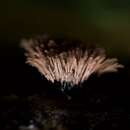Comprehensive Description
provided by North American Flora
Comatricha irregularis Rex, Proc. Acad. Phila. 1891: 393. 1891
Comatricha crypla Macbr. Bull. Nat. Hist. Univ. Iowa 2: 139. 1892. Probably not Stemonitis
crypta Schw. 1832. Comatricha longa /3 irregularis Lister, Mycet. 120. 1894.
Sporangia crowded in tufts, stipitate, cylindric, dark brown or nearly black, semi-erect or drooping, their total height 2-8 mm.; stalk black, relatively long, one-third to one-half the total height; hypothallus well developed, continuous, shining, dark red or silvery; columella slender, fiexuous, reaching the apex; capillitium loose, open, forming a large-meshed net toward the center, with numerous hyaline free ends, appearing hoary when the spores are dispersed; spores black in mass, often agglutinated, dark brown by transmitted light, strongly echinulate, 7.5-9.5 p in diameter; Plasmodium white. Type locality : Philadelphia, Pa.
Habitat: Dead wood, often corticate, and usually of deciduous trees.
Distribution: Maine to Manitoba and Washington (state), south to Pennsylvania and Texas, and in Puerto Rico; Malaya; Japan; Australia.
- bibliographic citation
- George Willard Martin, Harold William Rickett. 1949. FUNGI; MYXOMYCETES; CERATIOMYXALES, LICEALES, TEICHIALES, STEMONITALES, PHYSARALES. North American flora. vol 1. New York Botanical Garden, New York, NY

